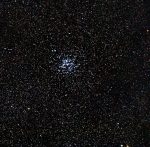It was the owl that shriek’d, the fatal bellman
Which gives the stern’st good-night.
~ William Shakespeare, MacBeth
Two of the most forsaken places in popular imagination are cemeteries at night and deep outer space. I spent an evening earlier this week at Norton Cemetery stargazing with a friend who has a really good telescope.

As we waited for twilight to deepen, a bat flitted over our heads. Eastern Coyotes wailed in the distance. As the night got underway, a Long-Eared Owl began her subtle one-note song.
The Ojibwe call death “crossing the owl bridge,” and the Tohono O’odham bury owl feathers with loved ones. The association in Western Europe of owls with death is thought to carry over from the pre-Indo-European practice of excarnation, the placement of dead bodies on platforms to be devoured by birds. But all the bodies in this cemetery were in the ground.

I heard the territorial scream of a Long-Eared Owl a few years ago, and I’ll never forget it. A friend and I were camping and awakened in the night by the sound, so piercing that we scrambled out of our sleeping bags trying to place it. In contrast, the single long note of the placid Long-Eared Owl could easily be missed if not repeated.
The stargazing was great. We looked at Saturn with his rings and Jupiter with his moons and debated how “Io” should be pronounced (I say EE-oh, you say EYE-oh).
One of the most awesome sights through the telescope, six thousand light years away, was the Wild Duck star cluster. It was discovered in 1681 by Gottfried Kirch and included in Charles Messier’s 1764 catalog (M-11). It is supposed to resemble the tale of a duck in flight. Honestly, I couldn’t see it, but it is a beautiful cluster.
